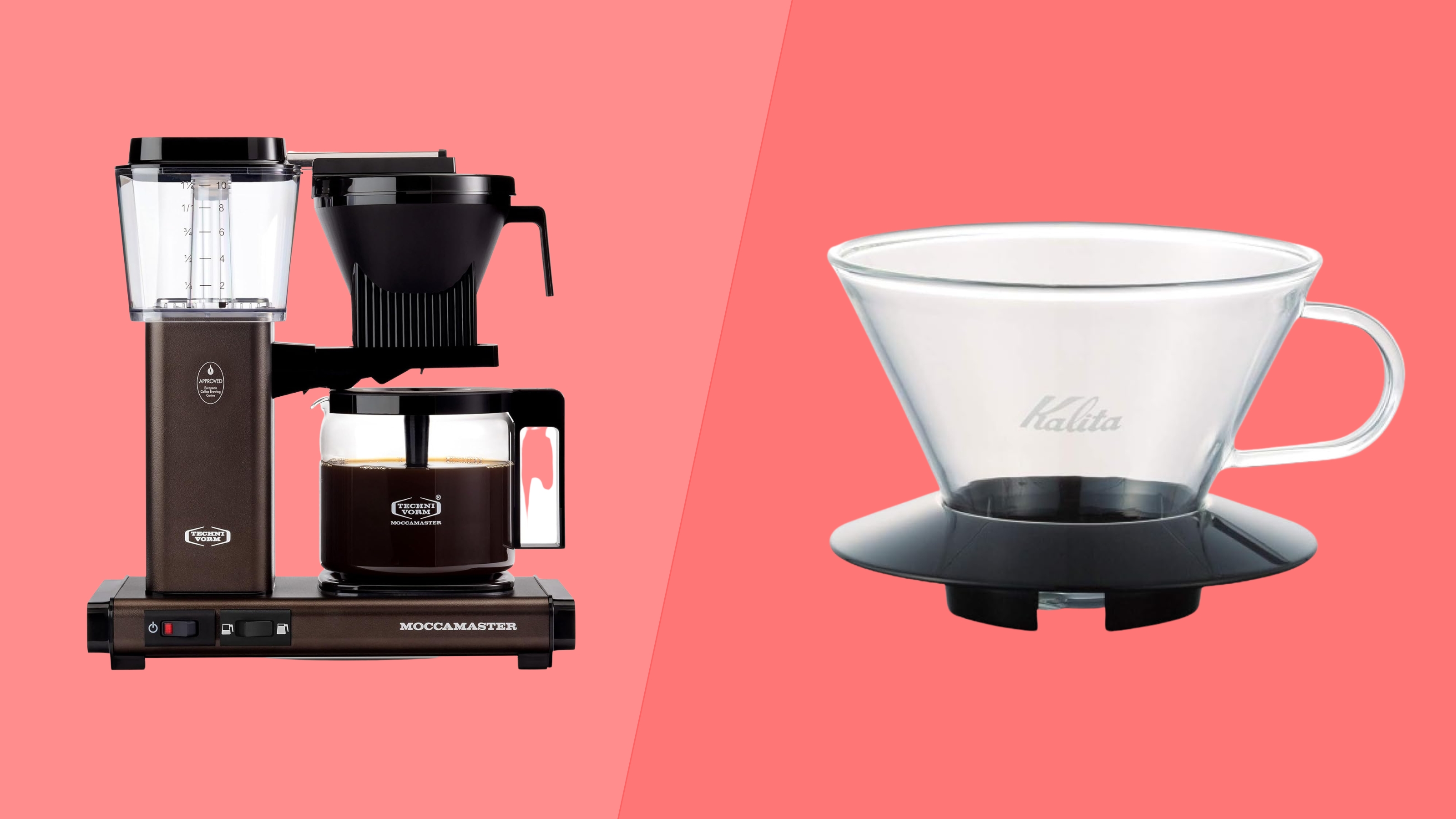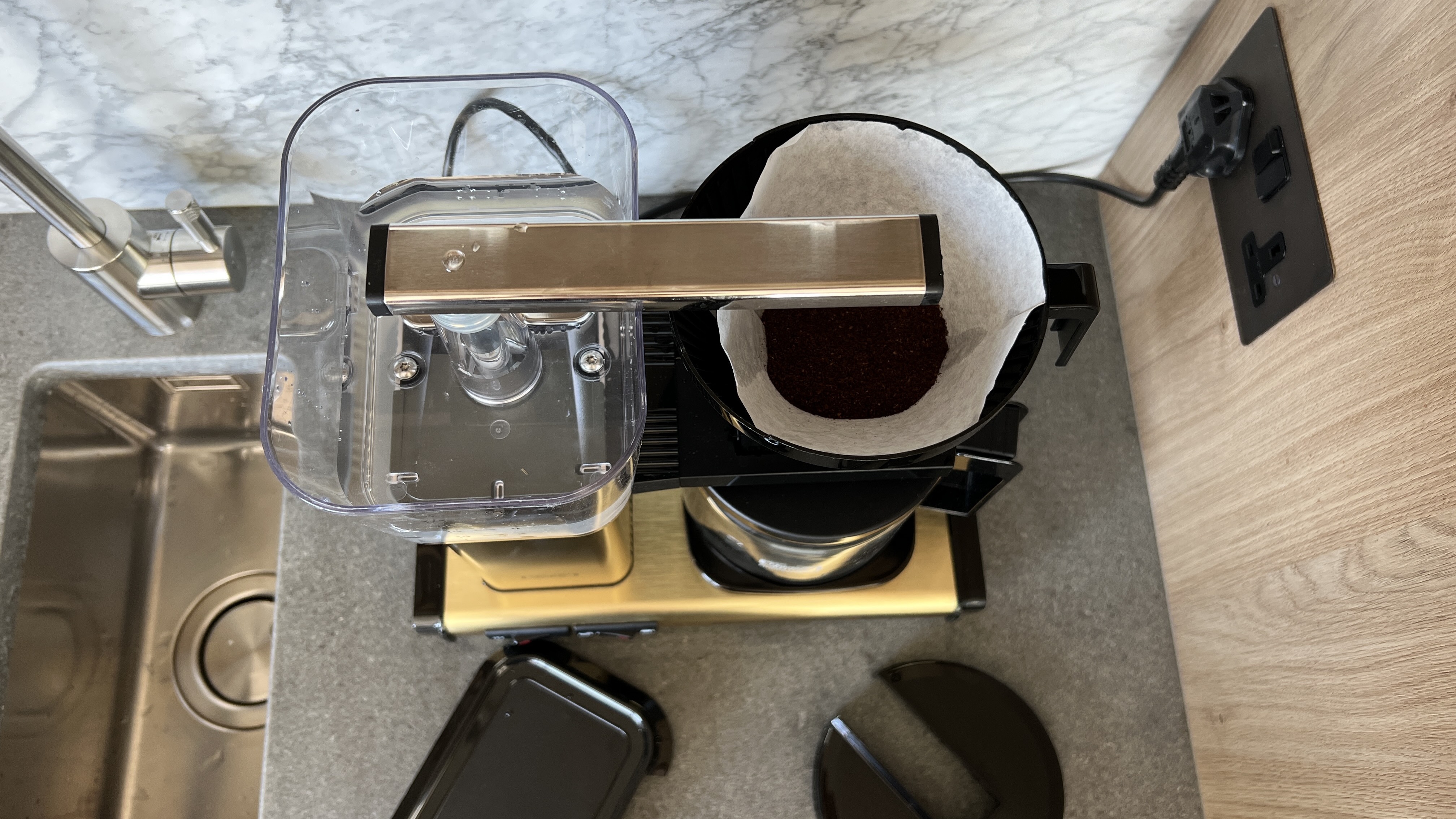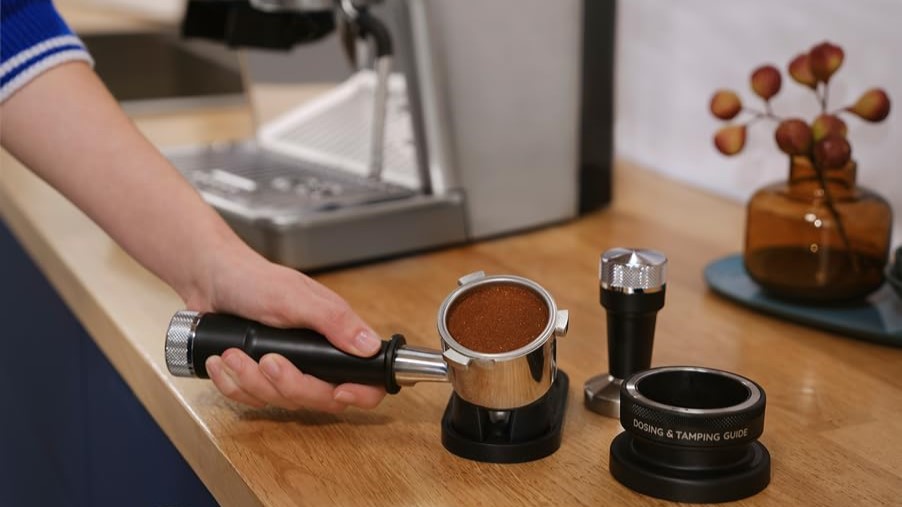
Water Capacity: 42 fl oz
Grind size: Medium/Coarse
Brew time: 4-6 minutes
The Moccamaster KBGV Select is a high-end drip coffee machine for people looking for a straightforward, no-nonsense approach to their daily coffee ritual. Designed to balance simplicity with performance, this Moccamaster uses medium/coarse grounds and a filter to create great-tasting jugs of coffee every time. It's more expensive than the average drip coffee machine, but for the extra money, you get the benefit of a precise heating element and a showerhead that has been engineered to make sure water is distributed evenly. Two features that seem small but make a large difference to the finished brew.
For
- Easy to use
- Consistent performance
Against
- Limited features
Water Capacity: 16-26 fl oz
Grind size: Medium/Coarse
Brew time: 4 minutes
Ideal for coffee enthusiasts who enjoy the process of manual brewing, the Kalita Wave takes a bit of practice and precision, particularly in terms of water temperature and pouring technique, but it's worth the effort. It features a flat-bottomed design with three small holes at its base, which helps give a more even and controlled water flow during brewing. It then uses specially designed wavy paper filters to create a smooth and even extraction by optimizing airflow and temperature. Available in glass, stainless steel, and ceramic.
For
- High level of customization and precision
- Affordable
Against
- Steep learning curve
- Requires additional accessories to enhance performance
While espresso machines are typically the coffee maker of choice for large chains, you're unlikely to find them in high-end shops where the art of brewing coffee is as important as the coffee itself.
Instead, many of the best baristas the world over use drip brewing, a technique in which water is poured over coffee grounds in order to make the fullest, most flavorsome extraction and brew highly customized cups of coffee.
"Drip coffee is made by combining water with coarse ground coffee," Alice Snow, Home Economist at Smeg UK, explains. "The drip coffee machine adds hot water into the coffee, which slowly drips into a carafe. This process extracts all of the delicious flavors from the grounds, relying on time and gravity to produce a fresh hot carafe of coffee."
Within this drip brewing market, there are two main contenders – drip coffee machines and pour-over coffee makers. Both involve the same processes, but drip coffee makers are designed for simplicity; they're usually all-in-one, automatic machines that make consistent cups of coffee every time.
Pour-over coffee makers are instead manual and are designed to offer the maximum amount of control over the brewing process. This makes them harder to use – despite their almost basic-looking design – but they give the highest customization options of any brewing method.
To help you determine which is the best coffee maker for you, we explain how the two methods compare in our drip coffee vs pour-over coffee guide below. We compare the designs, features, performance, and price of examples such as the Moccamaster KBGV Select and the Kalita Wave Pour-Over Coffee Dripper.
We've previously explained how drip coffee compares to espresso in our drip coffee vs espresso guide.
Drip coffee vs pour-over coffee: Design
Drip coffee machines, like the Moccamaster KBGV Select, are built to be practical and easy to use.
They typically consist of a water reservoir, a heating element, and a "showerhead" that sits above a basket for the coffee grounds. All are built into a single unit. At the press of a button or flick of a switch, water in the reservoir is heated up before being poured – or, more accurately, sprayed – over coffee grounds inside a filter placed in the basket. This causes drops of filtered coffee to drip through to a jug positioned on a heated plate below the basket.
Drip coffee machines have few bells and whistles and are designed to deliver a consistent cup of coffee every time. They're often compact, too, designed to fit comfortably on a kitchen counter without taking up too much space.
The downside of this design is that it leaves little room for customization. You can use different filters or experiment with different types and grinds of coffee grounds within certain limits, but that's about it.
With pour-over coffee, you can choose the manual or the automatic method. Manual setups have minimal designs that are focused more on the process than on the "machine" itself. Hot water is poured manually in swirling motions over coffee grounds using a kettle. The water then passes through a filter fitted inside a dedicated dripper.
With manual pour-over setups, you need to buy the coffee dripper itself, as well as the kettle, filters, and a suitable carafe or cup. The best kettles for manual pour-over coffee are known as gooseneck kettles because they have long, thin, curved spouts designed to give maximum control as you pour the water.
This pour-over method is much less about automated convenience and more about the control and customization it offers. It allows you to control the water temperature, for instance, as well as the height and speed of the pour. All of which affect the taste of the coffee.
It is possible to buy automated and semi-automated pour-over coffee machines. They differ slightly from drip coffee in that they swap the showerhead for a spout that's designed to mimic the swirling motion of manual methods. These machines are relatively rare in comparison to other coffee makers but include the $149 / £169 KitchenAid Pour Over Coffee Brewer (Walmart), the $329 / £250 Breville Precision Brewer (Amazon), as well as the semi-automated machines from Poursteady.
There's a fine line between when an automated pour-over coffee machine becomes a drip coffee maker, and true coffee purists will say that if it's automated, it's not true pour-over coffee, but there are at least some options.
Verdict: If you're looking for a machine that's practical and simple to use, you'll prefer a drip coffee machine like the Moccamaster. It's functional and does its job consistently. However, if you're someone who sees coffee-making as more of an art form and is willing to invest time and effort, a pour-over dripper, like the Kalita Wave, offers a level of control and customization that drip machines can't match.

Drip coffee vs pour-over coffee: Features
Continuing its easy-to-use theme, most drip coffee machines have relatively basic features, from automated water heating and showerhead elements to an automatic shut-off. Spend a bit more, and you can get programmable timers, brew-strength controls, and sometimes even self-cleaning functions. Some advanced models, like the Gevi Grind and Brew Drip Coffee Maker, even come with built-in grinders. Occupying a sweet spot of convenience and consistency.
Pour-over coffee equipment, on the other hand, is almost non-apologetic about its lack of features. As the method is all about control, the brewing variables are largely down to the person doing the pouring. The shape of the dripper and the corresponding filters can be technically considered "features" because they can affect the end result, but they're not features in the traditional sense.
Automated pour-over coffee machines, on the other hand, introduce a number of features. Depending on the model, you can select the temperature of the water and the speed of the pour. On the Breville Precision Brewer, for instance, you can select from presets – gold, fast, strong, iced, cold brew – and even design your own preset. Each preset will then select the appropriate speed, movement, and temperature.
This is because the hotter the water, the more energy the water molecules gain from the heat. This causes them to move faster, increasing their interactions with the coffee molecules, and the more these molecules interact, the greater the extraction.
"Water and coffee grounds are the two key ingredients, so it is essential these are the correct temperature and size," continues Snow. "The water must be hot but not boiling. Hot water enables the extraction of oils and flavors, whereas boiling water burns the coffee and leaves a bitter aftertaste."
Anything above 205°F (96°C) is considered too hot, while the Specialty Coffee Association recommends a temperature of 200°F (93.33°C). Temperatures above 195°F (90°C) should also work, depending on the type of coffee.
If the water isn't hot enough, however, there aren't enough interactions to obtain a full extraction. This can leave coffee tasting weak and bland.
Verdict: If you're someone who wants a simple, no-fuss coffee-making experience, and you like coffee pretty much as it comes, a drip coffee machine will be your best bet. If you're a purist looking for a coffee maker that allows you to experiment and fine-tune your brew, then a manual pour-over coffee maker is your best bet. However, if you sit somewhere in between, the automated pour-over machines represent a good balance of convenience and customization. They're also a good introduction to pour-over brewing before you take the leap into fully manual.
Drip coffee vs pour-over: Performance & Taste
Due to the fact drip coffee machines are known for their consistent performance, the coffee they produce is well-balanced, with a clean and straightforward flavor profile.
The brewing process allows for a balanced and slower extraction of oils and aromatics from the coffee grounds, and this results in a cup that is less intense than espresso but still rich in flavor. Any variations in taste will largely come from your choice of grounds. As a result, drip coffee tends to err on the less acidic, milder side, which is ideal for everyday coffee drinkers who don't want to sacrifice taste for added convenience.
Automated pour-over coffee machines take the performance and taste of drip coffee makers a step further. The results are similarly consistent and reliable, and the flavor profile is well-balanced, but the fullness of the taste and finish varies more, depending on the settings you choose.
With both drip and pour-over methods, your choice of coffee grounds impacts the taste, too.
"Coffee grounds should be coarse for a drip machine. This is due to the length of infusion time. Coarse ground coffee allows the water to steadily drip through, creating a deliciously infused coffee over the period of brewing," says Snow. "If the grounds are too fine, the water cannot easily pass through. This will create a longer brew time, resulting in over-extracted coffee, being too thick, dark, and tar-like."
In our experience, the best-tasting, most robust, and full-flavor profiles of coffee come from manual pour-over methods. The precise extraction process brings out the complexities of the coffee, including its acidity, sweetness, and aromatics. There is huge room for error with this, and getting one variable wrong can impact the rest of the extraction.
Realistically, as long as you don't "burn" the grounds or rush the process, coffee from pour-over makers is still superior to any coffee we've ever made with automated machines. You're unlikely to notice the variations in the flavor profile unless you're a keen coffee fan.
Verdict: Considering how similar the processes seem at first glance, it's in their respective performances and tastes where their biggest differences come to light. If you prefer a consistent, balanced – albeit slightly milder – cup of coffee, a drip coffee machine may be the better option for you. If you instead enjoy the intricacies of flavor and don't mind putting in the effort for a perfect cup, a pour-over maker is likely the better choice.

Drip coffee vs pour-over: Care & Maintenance
Maintaining a drip coffee machine is relatively straightforward. Regular cleaning of the carafe and the basket helps to prevent coffee oil buildup, and periodic descaling helps to remove mineral deposits. These tasks are generally simple and don't require much time or effort. The simplicity of the machine's design also means there are fewer parts that can malfunction or require replacement, making it a low-maintenance option for everyday use.
Despite how basic the individual components of manual pour-over coffee equipment are, everything from the kettle to the dripper and carafe needs to be cleaned thoroughly after each use to ensure the best possible taste. Oils left on the inside of the cup or residue on the dripper that prevents the filter from doing its job properly can make a difference to the taste and quality of your coffee.
The plus side, though, is that the simplicity of the equipment makes this relatively easy. There are no complex parts or mechanisms to deal with, and the manual nature of the equipment means there are fewer things that can go wrong or break down over time.
Verdict: Pour-over equipment, while requiring more regular and thorough cleaning, is easy to maintain due to its simplicity. This method is well-suited for people who don't mind the extra effort in cleaning for the sake of a more artisanal brewing experience. Drip coffee machines are similarly simple and low-maintenance. Their cleaning requirements and few mechanical parts make them less prone to issues than, say, one of the best espresso machines, and this makes them more suited for busy people.
Drip coffee vs pour-over coffee: Price
The price range varies for drip coffee machines, with options available for most budgets.
Basic models like the $19.99 Elite Gourmet Coffeemaker (Best Buy) are affordable and offer the essential features needed for brewing consistent coffee. More advanced mid-range models, such as the $70 Hamilton Beach 2-Way Machine (Amazon), come with additional features like programmable settings and auto-shut-off. At the premium end of the spectrum, you're either paying for precise engineering, which translates to great tasting, consistent coffee and a long lifespan – as is the case with the $350 Moccamaster – or you're paying for extras such as grinders. This is the case with the Gevi Grind and Brew Drip Coffee Maker (Walmart).
Automated and semi-automated pour-over machines tend to be more expensive by default because they're designed to offer barista-level quality drinks. The Breville Precision Brewer (Amazon) costs $329.95, and it can cost all the way up to $11,900+ for a professional Poursteady.
At the opposite end of the scale, manual pour-over drippers cost as little as $13.99 for the likes of the Dowan Pour Over Coffee Dripper (Amazon) or $30-$55 for starter sets such as the Cosori 8-cup set (Amazon), or the Chemex 6-cup bundle (Amazon). Both bundles and those like them, come with cups and filters as well as the dripper itself. An average gooseneck kettle costs around $50. The prices vary based on material – drippers are sold in metal, plastic, and ceramic models – as well as brand name and shape.
When considering the price, it's important to factor in the additional costs, too. Both need filters, and you'll need to buy either coffee beans and a grinder or coffee grounds.
Price: As with most appliances, you can spend a little or a lot to get the best versions of both drip coffee and pour-over coffee makers, but you can get a decent model of each type for around the $50 mark. Pour-over coffee makers seem the cheapest, at face value, but once you've bought all of the components, from carafes to kettles, this price can soon mount up. As can the time costs needed to invest in perfecting your art. You'll also need more space for all of the pour-over coffee parts. At the same time, drip-coffee machines are typically all-in-one units and aren't as complex to learn.
Drip coffee vs pour-over coffee: Our verdict
It may appear that little separates drip coffee and pour-over coffee makers, and in terms of function and total price, that's largely true. However, in terms of appeal, they offer different selling points.
Pour-over coffee methods are best suited to those who enjoy the process of making coffee and have a keen interest in the nuances of flavor. This method requires more time and involvement but offers greater control over the brewing process. It's a method that appeals to those who view coffee brewing not just as a means to an end but as an enjoyable part of their daily routine.
By contrast, drip coffee machines offer an efficient and straightforward way to make coffee. You sacrifice flavor intensity and versatility, but it's perfect for people who enjoy a lighter, smoother cup of coffee without the fuss.
In summary, drip coffee machines are best for casual coffee drinkers and those who prefer convenience. Pour-over makers are best for coffee aficionados who are passionate about the intricacies of brewing the perfect cup.







